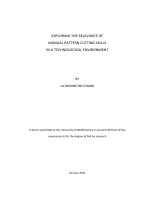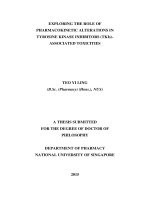- Trang chủ >>
- Sư phạm >>
- Sư phạm toán
Analytic number theory exploring the anatomy of integers jean marie de koninck, florian luca american mathematical society (2012)
Bạn đang xem bản rút gọn của tài liệu. Xem và tải ngay bản đầy đủ của tài liệu tại đây (3.14 MB, 434 trang )
Analytic
Number Theory
Exploring the Anatomy of
Integers
Jean-Marie De Koninck
Florian Luca
Graduate Studies
in Mathematics
Volume 134
American Mathematical Society
Analytic
Number Theory
Exploring the Anatomy of
Integers
Jean-Marie De Koninck
Florian Luca
Graduate Studies
in Mathematics
Volume 134
American Mathematical Society
Providence, Rhode Island
EDITORIAL COMMITTEE
David Cox (Chair)
Daniel S. Freed
Rafe Mazzeo
Gigliola Staffilani
2010 Mathematics Subject Classification. Primary 11A05, 11A41, 11B05, 11K65, 11N05,
11N13, 11N35, 11N37, 11N60, 11B39.
For additional information and updates on this book, visit
www.ams.org/bookpages/gsm-134
Library of Congress Cataloging-in-Publication Data
Koninck, J.-M. de, 1948–
Analytic number theory: exploring the anatomy of integers / Jean-Marie De Koninck, Florian
Luca.
p. cm. – (Graduate studies in mathematics ; v. 134)
Includes bibliographical references and index.
ISBN 978-0-8218-7577-3 (alk. paper)
1. Number theory. 2. Euclidean algorithm. 3. Integrals. I. Luca, Florian. II. Title.
QA241.K6855 2012 2011051431
512.7 4–dc23
Copying and reprinting. Individual readers of this publication, and nonprofit libraries
acting for them, are permitted to make fair use of the material, such as to copy a chapter for use
in teaching or research. Permission is granted to quote brief passages from this publication in
reviews, provided the customary acknowledgment of the source is given.
Republication, systematic copying, or multiple reproduction of any material in this publication
is permitted only under license from the American Mathematical Society. Requests for such
permission should be addressed to the Acquisitions Department, American Mathematical Society,
201 Charles Street, Providence, Rhode Island 02904-2294 USA. Requests can also be made by
e-mail to
c 2012 by the American Mathematical Society. All rights reserved.
The American Mathematical Society retains all rights
except those granted to the United States Government.
Printed in the United States of America.
∞ The paper used in this book is acid-free and falls within the guidelines
established to ensure permanence and durability.
Visit the AMS home page at />
10 9 8 7 6 5 4 3 2 1 17 16 15 14 13 12
Contents
Preface ix
Notation xiii
Frequently Used Functions xvii
Chapter 1. Preliminary Notions 1
§1.1. Approximating a sum by an integral 1
§1.2. The Euler-MacLaurin formula 2
§1.3. The Abel summation formula 5
§1.4. Stieltjes integrals 7
§1.5. Slowly oscillating functions 8
§1.6. Combinatorial results 9
§1.7. The Chinese Remainder Theorem 10
§1.8. The density of a set of integers 11
§1.9. The Stirling formula 11
§1.10. Basic inequalities 13
Problems on Chapter 1 15
Chapter 2. Prime Numbers and Their Properties 19
§2.1. Prime numbers and their polynomial representations 19
§2.2. There exist infinitely many primes 21
§2.3. A first glimpse at the size of π(x) 21
§2.4. Fermat numbers 22
§2.5. A better lower bound for π(x) 24
iii
iv Contents
§2.6. The Chebyshev estimates 24
§2.7. The Bertrand Postulate 29
§2.8. The distance between consecutive primes 31
§2.9. Mersenne primes 32
§2.10. Conjectures on the distribution of prime numbers 33
Problems on Chapter 2 36
Chapter 3. The Riemann Zeta Function 39
§3.1. The definition of the Riemann Zeta Function 39
§3.2. Extending the Zeta Function to the half-plane σ > 0 40
§3.3. The derivative of the Riemann Zeta Function 41
§3.4. The zeros of the Zeta Function 43
§3.5. Euler’s estimate ζ(2) = π2/6 45
Problems on Chapter 3 48
Chapter 4. Setting the Stage for the Proof of the Prime Number
Theorem 51
§4.1. Key functions related to the Prime Number Theorem 51
§4.2. A closer analysis of the functions θ(x) and ψ(x) 52
§4.3. Useful estimates 53
§4.4. The Mertens estimate 55
Đ4.5. The Măobius function 56
§4.6. The divisor function 58
Problems on Chapter 4 60
Chapter 5. The Proof of the Prime Number Theorem 63
§5.1. A theorem of D. J. Newman 63
§5.2. An application of Newman’s theorem 65
§5.3. The proof of the Prime Number Theorem 66
§5.4. A review of the proof of the Prime Number Theorem 69
§5.5. The Riemann Hypothesis and the Prime Number Theorem 70
§5.6. Useful estimates involving primes 71
§5.7. Elementary proofs of the Prime Number Theorem 72
Problems on Chapter 5 72
Chapter 6. The Global Behavior of Arithmetic Functions 75
§6.1. Dirichlet series and arithmetic functions 75
§6.2. The uniqueness of representation of a Dirichlet series 77
Contents v
§6.3. Multiplicative functions 79
§6.4. Generating functions and Dirichlet products 81
§6.5. Wintner’s theorem 82
§6.6. Additive functions 85
§6.7. The average orders of ω(n) and Ω(n) 86
§6.8. The average order of an additive function 87
§6.9. The Erd˝os-Wintner theorem 88
Problems on Chapter 6 89
Chapter 7. The Local Behavior of Arithmetic Functions 93
§7.1. The normal order of an arithmetic function 93
§7.2. The Tur´an-Kubilius inequality 94
§7.3. Maximal order of the divisor function 99
§7.4. An upper bound for d(n) 101
§7.5. Asymptotic densities 103
§7.6. Perfect numbers 106
§7.7. Sierpin´ski, Riesel, and Romanov 106
§7.8. Some open problems of an elementary nature 108
Problems on Chapter 7 109
Chapter 8. The Fascinating Euler Function 115
§8.1. The Euler function 115
§8.2. Elementary properties of the Euler function 117
§8.3. The average order of the Euler function 118
§8.4. When is φ(n)σ(n) a square? 119
§8.5. The distribution of the values of φ(n)/n 121
§8.6. The local behavior of the Euler function 122
Problems on Chapter 8 124
Chapter 9. Smooth Numbers 127
§9.1. Notation 127
§9.2. The smallest prime factor of an integer 127
§9.3. The largest prime factor of an integer 131
§9.4. The Rankin method 137
§9.5. An application to pseudoprimes 141
§9.6. The geometric method 145
§9.7. The best known estimates on Ψ(x, y) 146
vi Contents
§9.8. The Dickman function 147
§9.9. Consecutive smooth numbers 149
Problems on Chapter 9 150
Chapter 10. The Hardy-Ramanujan and Landau Theorems 157
§10.1. The Hardy-Ramanujan inequality 157
§10.2. Landau’s theorem 159
Problems on Chapter 10 164
Chapter 11. The abc Conjecture and Some of Its Applications 167
§11.1. The abc conjecture 167
§11.2. The relevance of the condition ε > 0 168
§11.3. The Generalized Fermat Equation 171
§11.4. Consecutive powerful numbers 172
§11.5. Sums of k-powerful numbers 172
§11.6. The Erd˝os-Woods conjecture 173
§11.7. A problem of Gandhi 174
§11.8. The k-abc conjecture 175
Problems on Chapter 11 176
Chapter 12. Sieve Methods 179
§12.1. The sieve of Eratosthenes 179
§12.2. The Brun sieve 180
§12.3. Twin primes 184
§12.4. The Brun combinatorial sieve 187
§12.5. A Chebyshev type estimate 187
§12.6. The Brun-Titchmarsh theorem 188
§12.7. Twin primes revisited 190
§12.8. Smooth shifted primes 191
§12.9. The Goldbach conjecture 192
§12.10. The Schnirelman theorem 194
§12.11. The Selberg sieve 198
§12.12. The Brun-Titchmarsh theorem from the Selberg sieve 201
§12.13. The Large sieve 202
§12.14. Quasi-squares 203
§12.15. The smallest quadratic nonresidue modulo p 204
Problems on Chapter 12 206
Contents vii
Chapter 13. Prime Numbers in Arithmetic Progression 217
§13.1. Quadratic residues 217
§13.2. The proof of the Quadratic Reciprocity Law 220
§13.3. Primes in arithmetic progressions with small moduli 222
§13.4. The Primitive Divisor theorem 224
§13.5. Comments on the Primitive Divisor theorem 227
Problems on Chapter 13 228
Chapter 14. Characters and the Dirichlet Theorem 233
§14.1. Primitive roots 233
§14.2. Characters 235
§14.3. Theorems about characters 236
§14.4. L-series 240
§14.5. L(1, χ) is finite if χ is a non-principal character 242
§14.6. The nonvanishing of L(1, χ): first step 243
§14.7. The completion of the proof of the Dirichlet theorem 244
Problems on Chapter 14 247
Chapter 15. Selected Applications of Primes in Arithmetic
Progression 251
§15.1. Known results about primes in arithmetical progressions 251
§15.2. Some Diophantine applications 254
§15.3. Primes p with p − 1 squarefree 257
§15.4. More applications of primes in arithmetic progressions 259
§15.5. Probabilistic applications 261
Problems on Chapter 15 263
Chapter 16. The Index of Composition of an Integer 267
§16.1. Introduction 267
§16.2. Elementary results 268
§16.3. Mean values of λ and 1/λ 270
§16.4. Local behavior of λ(n) 273
§16.5. Distribution function of λ(n) 275
§16.6. Probabilistic results 276
Problems on Chapter 16 279
Appendix: Basic Complex Analysis Theory 281
§17.1. Basic definitions 281
viii Contents
§17.2. Infinite products 283
§17.3. The derivative of a function of a complex variable 284
§17.4. The integral of a function along a path 285
§17.5. The Cauchy theorem 287
§17.6. The Cauchy integral formula 289
Solutions to Even-Numbered Problems 291
Solutions to problems from Chapter 1 291
Solutions to problems from Chapter 2 295
Solutions to problems from Chapter 3 303
Solutions to problems from Chapter 4 309
Solutions to problems from Chapter 5 312
Solutions to problems from Chapter 6 318
Solutions to problems from Chapter 7 321
Solutions to problems from Chapter 8 334
Solutions to problems from Chapter 9 338
Solutions to problems from Chapter 10 351
Solutions to problems from Chapter 11 353
Solutions to problems from Chapter 12 356
Solutions to problems from Chapter 13 377
Solutions to problems from Chapter 14 384
Solutions to problems from Chapter 15 392
Solutions to problems from Chapter 16 401
Bibliography 405
Index 413
Preface
Number theory is one of the most fascinating topics in mathematics, and
there are various reasons for this. Here are a few:
• Several number theory problems can be formulated in simple terms
with very little or no background required to understand their state-
ments.
• It has a rich history that goes back thousands of years when mankind
was learning to count (even before learning to write!).
• Some of the most famous minds of mathematics (including Pascal,
Euler, Gauss, and Riemann, to name only a few) have brought their
contributions to the development of number theory.
• Like many other areas of science, but perhaps more so with this
one, its development suffers from an apparent paradox: giant leaps
have been made over time, while some problems remain as of today
completely impenetrable, with little or no progress being made.
All this explains in part why so many scientists and so many amateurs
have worked on famous problems and conjectures in number theory. The
long quest for a proof of Fermat’s Last Theorem is only one example.
And what about “analytic number theory”? The use of analysis (real or
complex) to study number theory problems has brought light and elegance to
this field, in particular to the problem of the distribution of prime numbers.
Through the centuries, a large variety of tools has been developed to grasp
a better understanding of this particular problem. But the year 1896 saw
a turning point in the history of number theory. Indeed, that was the year
when two mathematicians, Jacques Hadamard and Charles Jean de la Vall´ee
Poussin, one French, the other Belgian, independently used complex analysis
ix
x Preface
to prove what we now call the Prime Number Theorem, namely the fact that
“π(x) is asymptotic to x/ log x” as x tends to infinity, where π(x) stands for
the number of prime numbers not exceeding x. This event marked the birth
of analytic number theory.
At first one might wonder how analysis can be of any help in solving
problems from number theory, which are after all related to the study of
positive integers. Indeed, while integers “live” in a discrete world, analysis
“lives” in a continuous one. This duality goes back to Euler, who had
observed that there was a connection between an infinite product running
over the set of all prime numbers and an infinite series which converges or
diverges depending on the value of real variable s, a connection described
by the relation
1 −1 1 −1 1 −1 11111
1 − 2s 1 − 3s 1 − 5s · · · = 1s + 2s + 3s + 4s + 5s + · · · ,
which holds in particular for all real s > 1. Approximately one century later,
Riemann studied this identity for complex values of s by carefully exhibiting
the analytic properties of the now famous Riemann Zeta Function
∞1 (Re(s) > 1).
ζ(s) = ns
n=1
By extending this function to the entire complex plane, he used it to establish
in 1859 a somewhat exceptional but nevertheless incomplete proof of the
Prime Number Theorem. Thirty-seven years later, Hadamard and de la
Vall´ee Poussin managed to complete the proof initiated by Riemann.
The methods put forward by Riemann and many other 20th-century
mathematicians have helped us gain a better understanding of the distri-
bution of prime numbers and a clearer picture of the complexity of the
multiplicative structure of the integers or, using a stylistic device, a better
comprehension of the anatomy of integers.
In this book, we provide an introduction to analytic number theory. The
choice of the subtitle “Exploring the Anatomy of Integers” was coined at
a CRM workshop held at Universit´e de Montr´eal in March 2006 which the
two of us, along with Andrew Granville, organized. For the workshop as
well as for this book, the terminology “anatomy of integers” is appropriate
as it describes the area of multiplicative number theory that relates to the
size and distribution of the prime factors of positive integers and of various
families of integers of particular interest.
Besides the proof of the Prime Number Theorem, our choice of subjects
for this book is very subjective but nevertheless legitimate. Hence, several
chapters are devoted to the study of arithmetic functions, in particular those
Preface xi
which provide a better understanding of the multiplicative structure of the
integers. For instance, we study the average value of the number of prime
factors of an integer, the average value of the number of its divisors, the
behavior of its smallest prime factor and of its largest prime factor, and
so on. A whole chapter is devoted to sieve methods, and many of their
applications are presented in the problem section at the end of that chapter.
Moreover, we chose to include some results which are hard to find elsewhere.
For instance, we state and prove the very useful Birkhoff-Vandiver primitive
divisor theorem and the important Tur´an-Kubilius inequality for additive
functions. We also discuss less serious but nevertheless interesting topics
such as the Erd˝os multiplication table problem.
We also chose to discuss the famous abc conjecture, because it is fairly
recent (it was first stated in 1985) and also because it is central in the study
of various conjectures in number theory. Finally, we devote a chapter to
the study of the index of composition of an integer, its study allowing us to
better understand the anatomy of an integer.
To help the reader better comprehend the various themes presented in
this book, we listed 263 problems along with the solutions to the even-
numbered ones.
Finally, we are grateful to our former students who provided important
feedback on earlier versions of this book. In particular, we would like to
thank Maurice-Etienne Cloutier, Antoine Corriveau la Grenade, Michael
Daub, Nicolas Doyon, Ross Kravitz, Natee Pitiwan, and Brian Simanek.
We are very appreciative of the assistance of Professor Kevin A. Broughan,
who kindly provided mathematical and grammatical suggestions. We would
also like to thank the anonymous reviewers of the AMS for their clever
suggestions which helped improve the quality of this book.
Jean-Marie De Koninck
Florian Luca
Notation
We denote respectively by N, Z, Q, R, and C the set of positive integers,
the set of integers, the set of rational numbers, the set of real numbers, and
the set of complex numbers. At times, we shall let R+ stand for the set of
positive real numbers.
A number ξ is said to be algebraic if it is the solution of a polynomial
equation, that is, if there exist integers k ≥ 1 and a0 = 0, a1, . . . , ak such that
a0ξk + a1ξk−1 + · · · + ak−1ξ + ak = 0. A number ξ is said to be transcendental
if it is not algebraic.
We let e stand for the naperian number and we let π stand for the ratio of
the circumference of a circle to its diameter. Both e and π are transcendental
numbers.
We write γ for the Euler constant, which is defined by
γ = lim N1 = 0.5772156649 . . . .
n − log N
N →∞
n=1
Most of the time, we use the letters k, , m, n, r and α, β to designate
integers and x, y to designate real numbers. The letters C and c, with
or without subscript, are usually reserved for positive constants, but not
necessarily the same at each occurrence. Similarly, the letters p and q, with
or without subscript, will normally stand for prime numbers. Unless we
indicate otherwise, the sequence {pn} stands for the increasing sequence of
prime numbers, that is, the sequence 2, 3, 5, 7, 11, 13, 17, . . . .
By x , we mean the largest integer smaller or equal to x. Tied to this
function is the fractional part of x defined by {x} = x − x .
The expression pa b means that a is the largest integer for which pa | b.
xiii
xiv Notation
We write lcm[a1, a2, . . . , ak] to denote the least common multiple of the
positive integers a1, a2, . . . , ak. Similarly, we write gcd(a1, a2, . . . , ak) to de-
note the greatest common divisor of the positive integers a1, a2, . . . , ak; when
the context is clear, we may at times simply write (a1, a2, . . . , ak) instead of
gcd(a1, a2, . . . , ak), as well as [a1, a2, . . . , ak] instead of lcm[a1, a2, . . . , ak].
Throughout this book, log x stands for the natural logarithm of x. At
times, we also write log2 x instead of log log x and more generally, for each
integer k ≥ 3, we let logk x stand for log(logk−1 x).
For each integer k ≥ 0, we denote by Ck[a, b] the set of functions whose
kth derivative exists and is continuous on the interval [a, b]. Thus C0[a, b]
stands for the set of continuous functions on [a, b].
It is often convenient to use the notations introduced by Landau, namely
o(. . .) and O(. . .), to compare the order of magnitude of functions in the
neighborhood of a point or of infinity. Unless we indicate otherwise, we
shall mean the latter.
Given two functions f and g defined on [a, ∞), where a ≥ 0 and g(x) > 0,
we shall write that f (x) = O(g(x)) if there exist two constants M > 0 and
x0 such that |f (x)| < M g(x) for all x ≥ x0. In particular, f (x) = O(1) if
f (x) is a bounded function. Moreover, instead of writing f (x) = O(g(x)),
we shall at times write f (x) g(x).
Thus, we have, as x → ∞,
x = O(x2), sin x = O(1), log x = O(x1/10),
sin x x4 = O(ex), ex sin x = O(ex),
= O(1), x3+x2 x3 + 7 = O(1).
x
2x2 + x x2,
3
Given two functions f and g defined on [a, ∞), where a ≥ 0 and g(x) > 0,
we shall write f (x) = o(g(x)) as x → ∞ if, for each ε > 0, there exists a
constant x0 = x0(ε) such that |f (x)| < εg(x) for all x ≥ x0.
Thus, we have
1 = o(1), sin x = o(x), log x = o(x),
x
sin 1/x 1/x = 1 + o(1), x4 = o(ex), xex sin x = o(x2ex).
Notation xv
Given two functions f and g defined on [a, ∞) (where a ≥ 0), we shall
write f (x) g(x) if there exist two constants M > 0 and x0 such that
|f (x)| > M |g(x)| for all x ≥ x0.
Thus, we have
√ 2 + sin x √ log x,
x x, 1, x
1 + sin x x 1, ex x4, xex ex.
On the other hand, given two functions f and g defined on [a, ∞) (where
a ≥ 0), we write f (x) ∼ g(x) to mean that lim f (x) = 1.
x→∞ g(x)
Thus, as x → ∞,
sin 1/x ∼ 1, x2 + x ∼ x2.
1/x
Finally, we write that f (x) g(x) if we simultaneously have f (x) g(x)
and g(x) f (x). Observe that f (x) g(x) if and only if
0 < lim inf f (x) ≤ lim sup f (x) < ∞.
x→∞ g(x) x→∞ g(x)
Frequently Used
Functions
P (n) = max{p : p|n}, the largest prime factor of n ≥ 2
p(n) = min{p : p|n}, the smallest prime factor of n ≥ 2
Ψ(x, y) = #{n ≤ x : P (n) ≤ y}
Φ(x, y) = #{n ≤ x : p(n) > y}
β(n) = p, the sum of the prime factors of n
p|n
π(x) = 1, the number of prime numbers ≤ x
p≤x
θ(x) = log p
p≤x
ψ(x) = log p
pα ≤x
α≥1
π(x; k, ) = 1, the number of prime numbers p ≤ x, p ≡ (mod k)
p≤x
p≡ (mod k)
li(x) = x dt , the logarithmic integral
0 log t
xvii
xviii Frequently Used Functions
γ(n) = p, the product of the prime numbers dividing n
p|n
φ(n) = 1, the Euler φ function
m≤n
(m,n)=1
σ(n) = d, the sum of the (positive) divisors of n
d|n
σk(n) = dk, the sum of the k-th powers of the divisors of n
d|n
d(n) = 1, the number of divisors of n
d|n
ω(n) = 1, the number of distinct prime divisors of n
p|n
Ω(n) = α, the number of prime factors of n counting multiplicity
pα n
Πk(x) = 1, the number of integers n ≤ x such that ω(n) = k
n≤x
(n)=k
(n), the Moăbius function, defined by
⎧
⎨1 if n = 1,
μ(n) = 0 p2|n for some prime p,
⎩ (−1)ω(n) otherwise.
λ(n) = log n , the index of composition of the integer n ≥ 2
log γ(n)
Chapter 1
Preliminary Notions
1.1. Approximating a sum by an integral
In certain situations, it is useful to replace a sum by an integral. The
following result shows when and how this can be done.
Proposition 1.1. Let a, b ∈ N with a < b and let f : [a, b] → R be a
monotonic function on [a, b]. There exists a real number θ = θ(a, b) such
that −1 ≤ θ ≤ 1 and such that
b
(1.1) f (n) = f (t) dt + θ(f (b) − f (a)).
a
Proof. Indeed, assume that f is decreasing, in which case, using a geometric
approach, it is easy to see that
b
0 < f (t) dt − f (n) < f (n) − f (n) = f (a) − f (b),
a a
from which (1.1) follows easily. If on the other hand, f is increasing, the
same type of argument yields (1.1).
One can use this result to estimate log n!. Indeed, setting f (n) = log n
in (1.1), one obtains
n n
log n! = log i = log t dt + θ(log n − log 1) = n log n − n + O(log n),
i=1 1
thus providing a fairly good approximation for log n!. A better estimate is
proved in Section 1.9.
1









